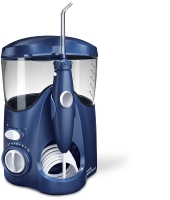Since even the expensive natural toothpastes out there often contain flouride or sodium lauryl sulphate (SLS -- nasty stuff!), I make my own. I have tried (and discarded as just plain too unpalatable to use) the many baking soda and salt mixes. Ditto, those containing peroxide. While they will work, they are horrible tasting and even make my gums sore -- especially recipes heavy on the baking soda and salt -- sea salt or otherwise. After several years of experimentation, this is what I have come up with. It looks, feels and tastes like commercial toothpaste, but it contains NO flouride, NO SLS and it costs pennies once past the initial investment for a couple of more expensive ingredients you will need. This is what you need...
Coconut oil
Vegetable glycerin
Baking soda
Salt
Clove oil (for sensitive teeth) optional
Tea Tree oil (for gum problems) optional
Stevia powder to sweeten if desired, but not necessary (the glycerin sweetens it pretty well anyway)
Filler -- either food grade calcium carbonate (chalk); or food grade aluminum oxide (clay); OR, if you don't mind the color, you could use finely ground activated charcoal. (The latter does not look, feel or taste like regular toothpaste, but does work.)
Flavoring: I recommend using a mint oil or extract because it has a toothpastey sort of taste, but I have made delicious toothpaste flavored with anise, banana/cherry (sort of tutti-frutti taste) and several other food flavors. Just use whatever you like or nothing at all -- its a matter of personal preference.
If you live near a big
city, you can probably find all this locally, but if not, it is readily available
online. You can get organic or regular coconut oil and essential oils, but plan to pay at least a third more upfront for organic. Check out Mountain
Rose Herbs
http://www.mountainroseherbs.com/ for most of this, (very reputable company) and get the powders (chalk and clay, charcoal) from a chemical or scientific supply place (Essential Depot has a lot of the
soap making supplies like sodium hydroxide and potassium hydroxide, but they also carry some other products of interest to homesteaders -- like the glycerin and coconut oil
http://www.essentialdepot.com/servlet/the-Glycerin-USP-Kosher-Vegetable/Categories ). As a last resort, Amazon.com does carry the powders in small containers. You want pharmaceutical or food grade because these are abrasives and you really don't want to be scratching your teeth with sand and other impurities. Besides, you get the finest grade powders that way (and the best prices, because you can buy in bulk quantities). Don't get any of it at a health food store! You will pay a hundred times more for a fraction of the quantity.
DISCLAIMER: I originally used the aluminum oxide powder because it is a primary ingredient in all of the off-the-shelf toothpastes (go read your label), BUT... it has been recently linked (although not conclusively) to Alzheimer's Disease. You may not be comfortable taking a chance with that, so while it does have a better mouth feel and provide a creamier consistency to the paste, it may be better to substitute chalk or charcoal. You can even leave it out altogether, but the toothpaste becomes tooth "milk" and is hard to keep on your brush. Also coconut oil becomes rock solid at below about 70F and runny above about 80F, so mix it very thoroughly while it is in a creamy in-between stage, store in a relatively cool place and stir the mix occasionally to keep it all from separating.
Now about the mixture proportions...
As I mentioned, I am not a fan of the baking soda and salt taste, so I experimented quite a bit to get the texture and taste I found pleasing. You will need to do that as well, but to start, you need to mix the filler, coconut oil and glycerin in approximately equal proportions. Add the flavoring (and the stevia, and clove or tea tree oils if you want those) to the glycerin before pouring it in to make sure it is uniformly distributed, then add only a pinch of salt; and finish by adding baking soda 1/4
tsp at a time until it seems right to you -- tasting as you go.
The initial outlay may set you back a few bucks, but depending upon the quantities you buy, you could have the makings for a decade of toothpaste for your entire family with that one purchase. Considering one tube of something like Jason's or Tom's of Maine cost around $8, it will pay for itself in a couple of months!









 Those tiny little brushes come in handy if you have gaps at the gum line.
Those tiny little brushes come in handy if you have gaps at the gum line.













 1
1


















